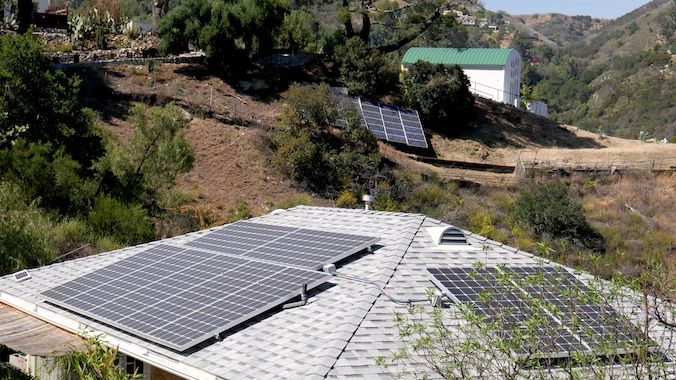An Energy Transition Means You Have To Do It All
Photo by Mike Nelson/EPA-EFE/Shutterstock
As part of the Biden Administration’s big Earth Week celebration, the president announced on Monday that $7 billion of Inflation Reduction Act money will be distributed through the new Solar For All program, enough to put solar panels on 900,000 low-income rooftops and trim 5 million tons of carbon dioxide emissions from the country’s ledger every year. Good!
Also, California has so much solar power now that electricity prices often go negative during the middle of sunny spring days and the grid operators basically throw a bunch of it away. Still good, but definitely less good.
- Bernie Sanders and Some Democrats Get Ready to Lick Elon’s Boots and Practice the Politics of the Past
- NBC Seems to Suggest a Children's Video Game is to Blame for UnitedHealthcare CEO's Killing
- Nancy Mace Is an Irredeemable Garbage Person Who Loves Bullying Vulnerable People and Yet the Media Still Believes Her
These things aren’t unrelated. California has been prepping for its energy transition for a long time, but officials there have still been caught by surprise. “We drastically underestimated the speed at which residential solar was going to come in,” one such official specifically tasked with leading the way on integration of renewable energy told The Washington Post. There would be ways to waste less of that daytime glut of cheap and emissions-free energy: batteries and better transmission capabilities, primarily. Either store the power until people get home from work and demand starts to spike, or send it off to other states where it might be put to use.
Both those solutions, though, are not moving at the same pace as solar, demonstrating a key piece of a legitimate energy transition: you have to do it all. Timelines for major infrastructure changes are a challenge, but lining them up is critical, especially when every extra year of emissions means that much longer until net-zero and that much bigger a climate change catastrophe.
Solar power, at this point, is something we generally know how to do; small rooftop installations are done in a day, and even big solar plants out in the desert are much more straightforward to build than most power generation facilities. Battery storage appears to be on the verge of a boom — there was essentially none a decade ago, and now the country has around 15 gigawatts; that is slated to double in 2024 alone — but it’s still in its infancy compared to renewable energy generation penetration.
Transmission, meanwhile, is mired in its own, largely separate morass. Permitting of large-scale transmission projects remains a bureaucratic nightmare, rife with delays and both federal and state roadblocks. And we will need a whole lot of those projects to get built in order to meet the coming demand. The interconnection queue, essentially a list of electricity generation projects waiting for permission to connect to the grid (this does not mean they are already built, and many such projects get abandoned and withdrawn from interconnection queues before a shovel hits dirt), has ballooned out of control: there were 1,570 gigawatts in the queue at the end of 2023, almost all of it renewable; that’s more than the entire installed electricity capacity of the United States.
Any piece of the transition that lags significantly behind the rest will hold it all up. Solar power that doesn’t have a battery home to go to, or a transmission line to send it somewhere else, is simply lost; obviously, this isn’t such a big deal from a total energy standpoint — the sun showers us with enough energy in less than half a day than the entire world actually uses in a year. But if the goal is to actually power, well, everything with renewable energy in the not-so-distant future — 2050, home of the world’s shiny net-zero goal, is as close to us today as the release of The Big Lebowski — then there needs to be an intentional effort to match the progress of the various pieces of the transition.